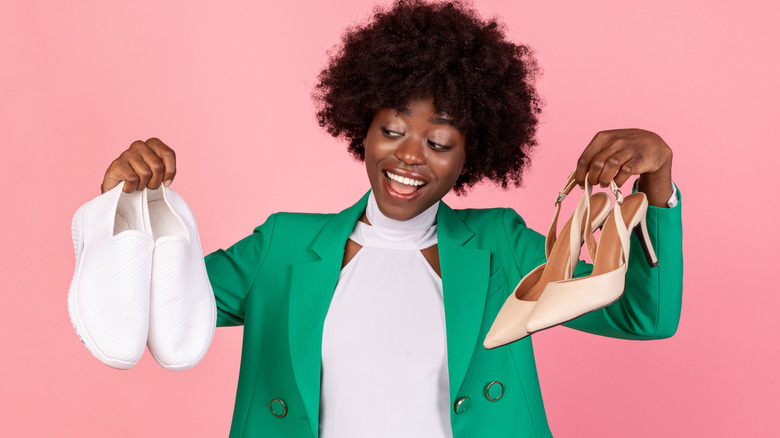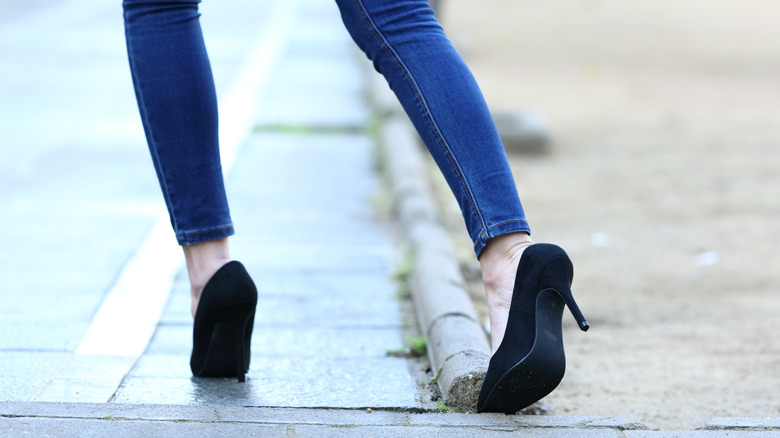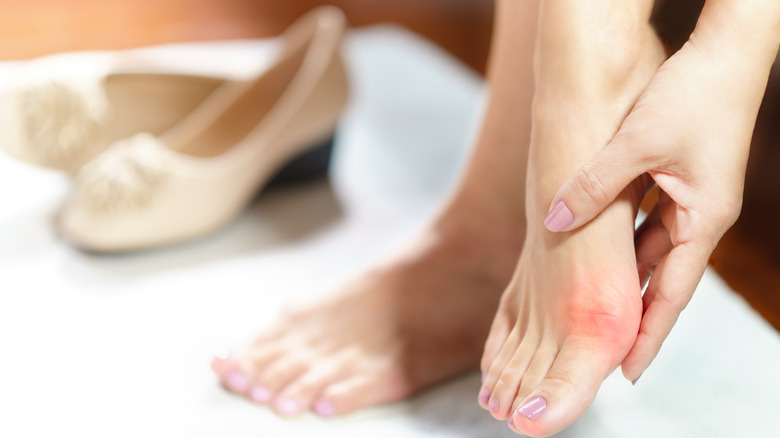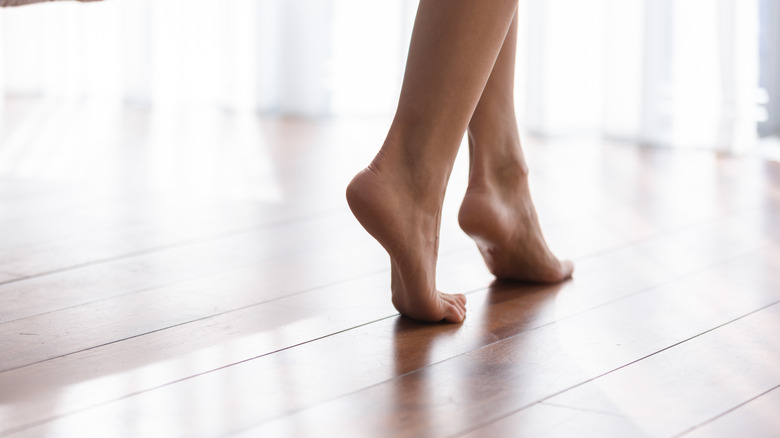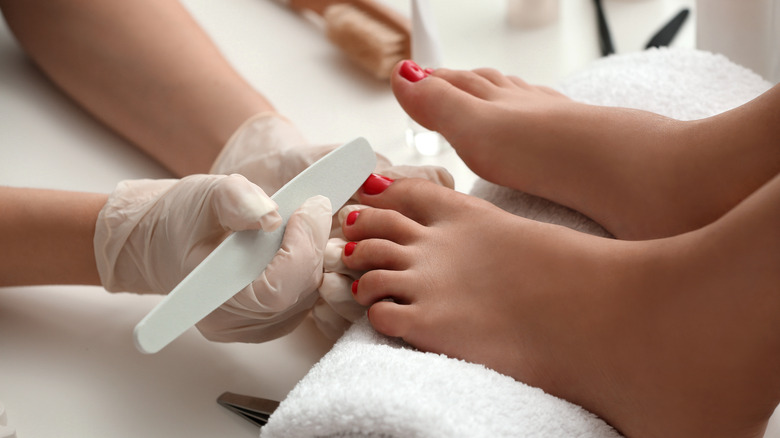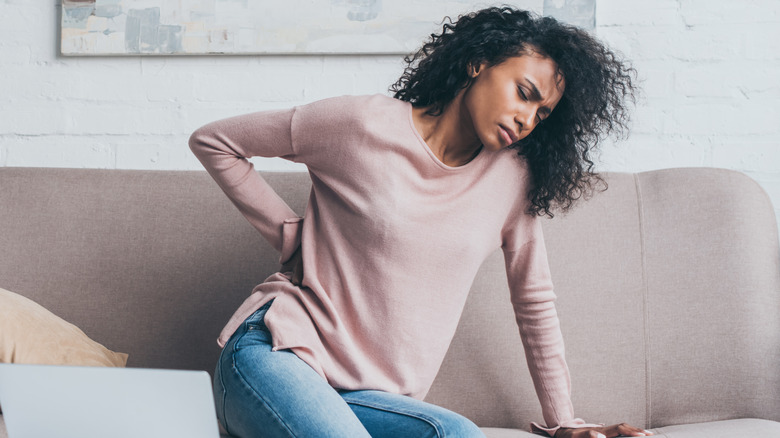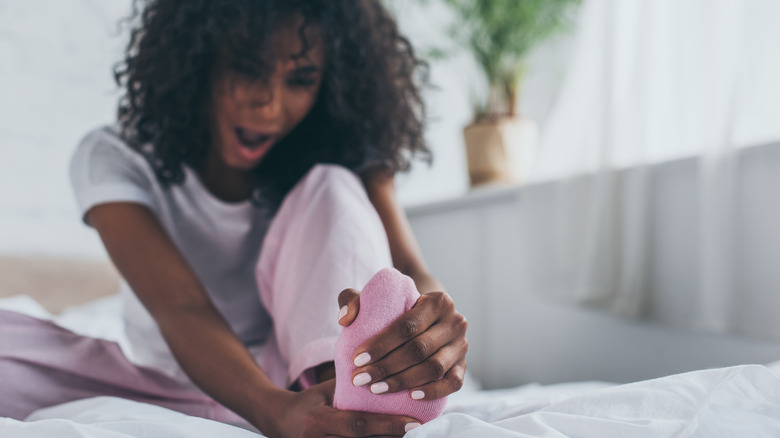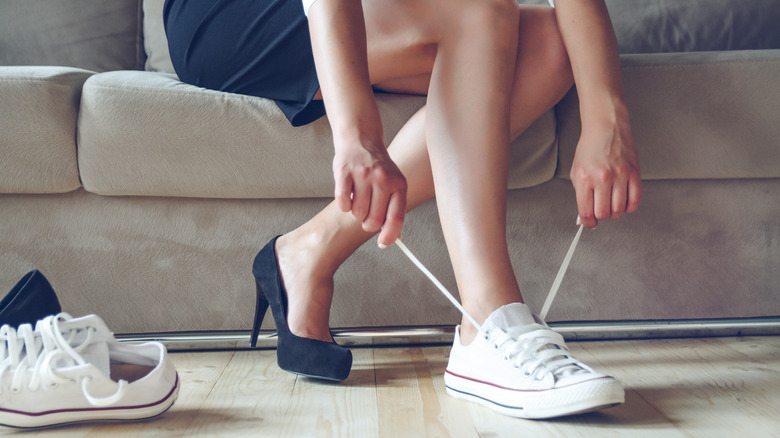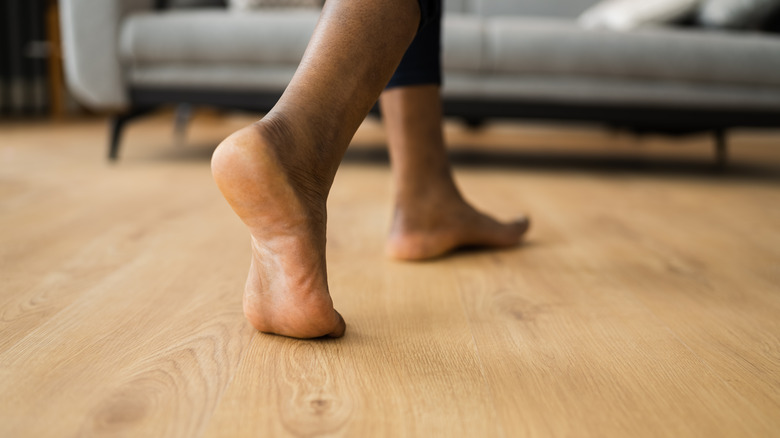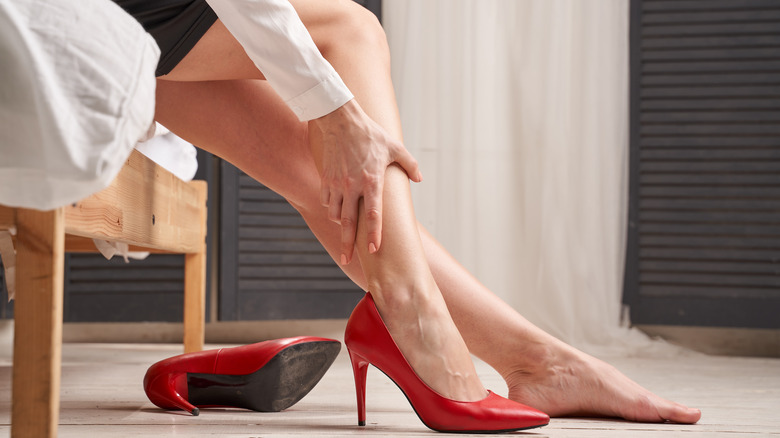When You Stop Wearing High Heels, This Is What Happens To You
There's something empowering about rocking a beautiful pair of high heels. High heels feel fierce and feminine. Whether it's a strappy stiletto, classic pump, or a more casual wedge, a heel is a fun way to jazz up any outfit. Pair the shoes with a dress or with some good ole' blue jeans, and make a statement. People have been wearing high heels since the 10th century (per Google Arts & Culture), and we continue to rock them on nights out on the town and in professional settings, like the office and lunch meetings.
Although many people wear high heels, it is certainly not because they are comfortable. We squeeze our feet into pointy and tall high heels and get used to walking around on the balls of our feet and our tippy toes. It doesn't feel great, that's for sure.
Wearing high heels, while fun, can cause some serious damage to your feet and your body overall. So much damage, in fact, that you might be considering giving them up. We hear you. Here's a look at what will happen if you do decide to retire your pumps to the back of the closet.
Walking will be safer
Have you ever rolled an ankle walking around in high heels? It sure is easy to do. The thing is that walking in heels is not exactly natural. (Okay, it's actually quite far from natural!) So you have to get used to walking around in them. And during the process — and even long after you have gotten comfortable — you can injure yourself. Like, seriously injure yourself. No, you don't have to be tipsy to do it...
"You could've just put on the shoe and headed out, literally take one step and step on a pebble, and then turn your foot inward and then either strain or break the ligament structures around what we call the lateral side of the ankle — so the outer part of the ankle — and it's called a lateral ankle sprain," Dr. Yolanda Ragland, a podiatrist and the founder of Fix Your Feet, told Insider.
Unfortunately, it really is that simple. Rocky roads, slippery floors, steep steps — they can all be recipes for disaster! When you ditch the heels, you'll have a lot more stability.
You may prevent bunions and hammer toes from getting worse
One of the worst parts of wearing high heels is the pain and discomfort around the toes. We're talking bunions and hammer toes. If you know, you know. The pain is real. And that shooting pain can travel up your legs.
"If you have bunions or hammer toes, wearing high heels can exacerbate those problems," Dr. Yolanda Ragland, a podiatrist and the founder of Fix Your Feet, told Insider. She also noted that, over time, bunions can actually grow and become more and more painful when you wear heels.
So imagine what could happen if you stop wearing heels. If you already have bunions or hammer toes, ditching the heels could relieve some of that pounding pain. While a lot of people end up having surgery to remove bunions, you may be able to stop its growth before it gets to that level (via Healthline). Choosing wider shoes with more support or going barefoot when you can will, at the very least, feel a lot better in the short term. You may still need to consult a podiatrist depending on the severity of the bunion.
You may have a tough time adjusting to walking without them
You've probably noticed that you walk differently in high heels. "Heels are not sneakers — you have to carry yourself differently," Marissa N. Stempien, fashion editor at Just Luxe told SheKnows. And, chances are, if you've gotten so used to wandering around in high heels you will also have a very difficult time getting used to walking around without them. That's because shoes like high heels can actually change your feet and the way you move. Yes, regular use of high heels can present a danger even when they are not on your feet.
"Prolonged use of high heels don't just put you at risk of injury while wearing them, you can also be at a greater risk of injury when you are not wearing them due to your body's ability to adapt," Matt Ferguson, the co-founder and president of Progressive Health Innovations Inc., told Insider. He continued, saying that this is because heels have been linked to many problems. The list includes plantar fasciitis, Achilles tendinopathies, calf and hamstring problems, chronic joint pain, hip and back pain, and more.
Your toenails will no longer be 'traumatized'
If you have ever stubbed a toe or jammed your toes into some seriously tight shoes, especially pointy high heels, you know toenail pain. For such a small part of your body, nail beds can cause a whole lot of pain when they're injured. They can also change in appearance.
"A lot of times ladies come in and they think that they have a fungal nail because the nail looks dystrophic or it looks strange, it doesn't look like it did before," podiatrist Yolanda Ragland told Insider. But, in reality, you probably just "traumatized" your toenails from wearing high heels so often, she explained.
Wearing open-toe shoes like sandals — particularly ones that don't put pressure on your toes (i.e. not heels!) — can be a savior for your feet. Your toes will move more freely, and your toenails won't be squished against the top of your shoes.
Your aches and pains may resolve
If you have been dealing with hip or back pain for quite some time, it is likely that you have exhausted most of the possible culprits. Hunching over at your computer desk all day. Leading a sedentary lifestyle. Sitting in the car for long commutes. But have you thought about your shoe situation? If you have been wearing high heels day in and day out, they could be why you have aches and pains.
"The reason heels are bad is because when you are in any kind of shoe that has elevation or a heel, your weight gets shifted forward to the ball of the foot," Jackie Sutera, a podiatric surgeon at City Podiatry in New York City, told Self. "The higher the heel, the more weight and pressure get shifted forward. Your knees and hips then have to push forward and your back has to hyperextend backwards to counterbalance." After all, your whole skeleton is misaligned, she explained.
Podiatrist Julie Schottenstein agrees. "High heels cause myriad problems for the wearer — not just in the feet, but also in the ankles, knees and even the back," she explained to SheKnows (via StyleCaster). Due to the transfer of weight, you'll be putting excess pressure on your knees, hips, and back. Tossing the heels and sticking to other types of shoes can help to ease this pain.
Your Achilles tendon may elongate
If you wear high heels for a long time and then switch to flat shoes, you may notice that your legs and feet feel tight. You know, all the muscles working together in there. It may not be so easy to walk because your Achilles tendon has actually shortened up over time. Yes, that really is possible.
"Because your foot is elevated and the weight goes forward, a lot of tension gets taken off the Achilles tendon and it shortens over time," Jackie Sutera, a podiatric surgeon at City Podiatry in New York City, confirmed to Self. "That's why a lot of women who are a little older don't feel good in flats, because the tendons are so tight from overuse of high heels their whole lives."
The more you go flat-footed again, however, the more you can stretch that tendon. Give it time and you will hopefully start to feel more comfortable walking sans the heels.
You can ease the pain of metatarsalgia
Wearing high heels for a prolonged period of time can lead to a type of foot pain called metatarsalgia. This happens when you wear off the natural padding on the bottom of your foot. So you start to feel pain, which can be throbbing, from the balls of your feet.
"What ends up happening with overuse is the fat pad on [the] bottom of the foot starts to become a lot thinner over time," podiatric surgeon Jackie Sutera told Self. "When you don't have a natural cushion anymore, you can get generalized pain on the bottom of the foot."
This process can happen even if you are not wearing high heels — we're looking at you, flip-flops. But wearing high heels all the time can certainly accelerate it. Ditching the dress shoes may slow down the process and provide some much-needed relief for your feet.
If you have plantar fasciitis, you may not want to ditch all of your high heels
Plantar fasciitis — it sounds as unfun as it is. Plantar fasciitis refers to inflammation of a thick line of tissue that goes across the bottom of your foot. This tissue ultimately connects your heel bone to your toes (plantar fascia), according to the Mayo Clinic. Plantar fasciitis can cause stabbing pains in your feet.
Interestingly, wearing high heels may actually help to alleviate the symptoms of it. That's right, wearing heels is not all bad! But we don't mean just any pair of heels. You still need to be selective in finding a supportive pair.
"For some foot conditions, like plantar fasciitis, wearing a small heel is actually helpful, and wearing very flat shoes is discouraged," podiatrist Julie Schottenstein told SheKnows (via StyleCaster). "Wearing a small heel, under 2 inches, can actually encourage the arch to lift, alleviating some discomfort and helping to stretch the fascia."
Ditching the heels may change how you're perceived by others
Did you know that taller people may make more money? Yes, science says so. According to 2004 research, the taller you are, the more money you could earn. In fact, a person who is 6 feet tall is predicted to make about $166,000 more over the course of their 30-year career than someone who is 5 feet and 5 inches. That's right: a few inches can make a difference of hundreds of thousands. "Back in our caveman days, we would have been wise to select tall, strapping people to lead the tribe because they'd be able to physically defend us — and that preference prevails even today," writes Shana Lebowitz for Business Insider about the research.
Studies also show that women who wear high heels are perceived differently than women in flats. According to Psychology Today, "As women normally walk differently from men, high heels may help exaggerate the particularly feminine aspects of gait." A study out of France also suggests that high heels are attractive (via Glamour). "Wearing high heels makes women look more long-legged and gives them a sexier posture," Mairi Macleod, an evolutionary biologist, told Glamour of the research. "This could lead some men to perceive women in heels as more sexually available, explaining why these women are approached more readily." Of course, it's up to you — not society — to determine if you want to wear heels or flats.
You'll decrease your risk of ingrown toenails
If you have ever worn heels for a long period of time — for a big night out or to the office all day — you know the feeling of finally freeing your cramped-up toes. It's a similar feeling to taking your bra off after a long day or finally finding and taking a seat after being on your feet all night. It's utter relief.
"Extended wear of high heels and continually bending your toes into an unnatural position can cause a range of ailments, from ingrown toenails to irreversible damage," according to LECOM Health. If you're having trouble parting with your heels, you're not alone. "Ingrown toenails can be painful, but many women are willing to cope with the discomfort in order to continue wearing their high heels," Rodney Stuck, professor of podiatry medicine, told Women's Health Research Institute. "However, more serious complications can arise and cause permanent damage to the toenail, if they are left untreated."
Kicking off your heels can feel liberating. Giving your toes a wiggle will certainly assuage some of the discomfort from being packed like sardines into your shoes for hours on end.
Your calves will have a chance to recover when you stop wearing heels
Wearing high heels can cause some serious pain in your calves. If you think about it, you are really working those leg muscles when you are basically standing on your tippy toes. One study by Marco Narici of Manchester Metropolitan University in the United Kingdom found that wearing high heels actually changes the shape of the calf muscles (via Live Science). When you wear heels, they raise your ankle, making your calf muscles shorter in a contracted position. And, if you do this for a long period of time, the muscle can become shorter and shorter.
This may make it uncomfortable when you first switch back to flats. If you don't want to give up your heels for good, Narici recommends stretching your calves after wearing your stilettos. This may just prevent your calf muscles from shortening.

